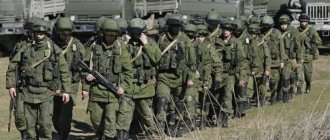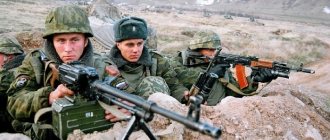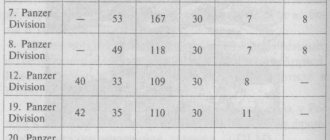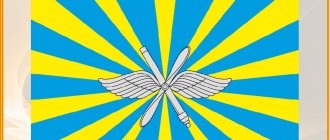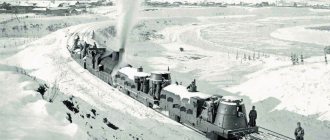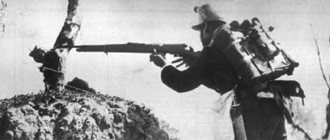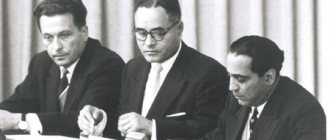Today, the Indian army is one of the ten most prepared among all world powers. Of course, the military potential of this country is significantly inferior to Russia or the United States, but the situation in the arms race can change every day. It is likely that very soon India will enter the top four, and this country will be feared and respected even by the most highly trained NATO countries. In our article you will find more detailed information about the composition of the Indian armed forces.
Why are the Indian Armed Forces so powerful?
Any military expert has asked a similar question at least once, but the answer is quite simple and understandable. The country has a population of about 1.3 billion people. Many foreign citizens also know India as one of the poorest countries, but its military budget is about $50 billion a year (almost the same as Russia). The Indian armed forces have about 1.4 million citizens, giving the country the third largest army in the world. Also, do not forget that India is one of the largest suppliers of weapons abroad. Well, the most important thing is that this country is armed with nuclear weapons and means of delivering them to strategic points, which makes us take this power seriously.
Also, the Indian Army has a huge number of armed formations created for a variety of purposes. About 1.1 million people serve in such organizations. As an example, we can cite the three most significant structures:
- special paramilitary forces;
- national security forces;
- special border forces.
According to the Indian Ministry of Defense, the country's mobilization resources are estimated at approximately 300 million citizens. Of these, almost 200 million are fully fit for military service in a wide variety of conditions and are ready to defend their homeland as soon as the hour comes.
Honorary titles
Brevet
Honorary ranks and honorary ranks, also called brevets, are awarded in the Indian Army and its branches such as the Indian Territorial Army (TA) for various reasons. These titles may not entitle the holder to payment, pension or benefits (such as titles given to celebrities).
Retired soldiers
Since British rule, exemplary soldiers about to retire have been given honorary titles, usually a few days before retirement, although these titles can be awarded at any time. Examples include attaining the rank of Field Marshal, which is rarely granted. Most often, honorary titles are awarded to junior officers, which are awarded 1-2 weeks before retirement.
Prominent Citizens as Brand Ambassadors
To inspire Indian youth to join the Indian Army and recognize contributions to the nation, honorary titles are awarded to experienced and eminent individuals who act as brand ambassadors for the defense forces. Honorary titles were awarded to:
- Indian Army Territorial Army (TA) Kapil Dev, 2008, Lieutenant Colonel, TA, Cricketer.
- Mohanlal Viswanathan, 2009, Lt Col, TA, Malayalam actor.
- Mahendra Singh Dhoni, 2011, Lieutenant Colonel, TA (Pair), Cricketer.
- Abhinav Bindra, 2011, Lieutenant Colonel, TA (Sikh Regiment), sports shooter and politician.
- Deepak Rao, 2011, Major, TA (pair), military trainer and author.
Foreign students of Indian military academies
Trainees from foreign countries who undergo training at Indian military academies such as the National Defense Academy (NDA) or the Indian Military Academy (IMA) are sometimes given honorary commissions in the Indian Army. Trainees are usually from friendly armies such as the Singapore Army.
Mutual conferment of honorary titles on other peoples
Nepal
Since 1950, when former Indian Army Chief General K.M. Cariappa visited Nepal, conferring the highest mutual honorary ranks on newly appointed serving commanders of each other's armies has become a practice followed by India and Nepal. For example, in 2009, the newly appointed Commander-in-Chief of the Nepal Army, General Chhatra Man Singh Gurung, was awarded the honorary title of General of the Indian Army in New Delhi by the President of India, who is also . Moreover, in 2010, the newly appointed Chief of the Indian Army, General K. Singh, was awarded the honorary title of General of the Nepal Army in Shital Niwas by the President of Nepal, who is also.
British Colonial Era: Indian Army takes the place of the British Army
Some members of the ruling families of princely states were given ceremonial honorary titles during the colonial era.
An 1832 journal reports that during the era of colonial British rule, the Commander-in-Chief of the British Army (the ex officio role of the sitting monarch of Great Britain) issued an order prohibiting a lieutenant-colonel of the HM (Royal British Army) from being replaced by a lieutenant-colonel of the East India Company's Indian Army. Whenever a Lieutenant Colonel of the Indian Army was promoted to Colonel, all Lieutenant Colonels of the British Army who were deployed with the Indian Army and had equal dates and rank with the newly promoted Colonel of the Indian Army were also mandatorily given the local Indian Army honorary rank. Colonel since his rank as Lieutenant Colonel in the British Army. This unjust system maintained the fictitious equivalence of British Army officers with Indian Army officers, while depriving Indian Army officers of their hard-earned honors and ranks as part of their special service. It was not a reciprocal system, i.e. a Lieutenant Colonel of the East India Company (EIC) (Indian Army) was not promoted to the rank of Colonel when a Lieutenant Colonel of the British Army of the same rank and date was promoted to the rank of Colonel in the Indian Army. For example, when a Lieutenant Colonel of the Indian Army in Bengal was promoted to the rank of Colonel, he was ranked 34th in the overall list, he replaced 33 other Lieutenant Colonels of the Indian Army, as well as all the Lieutenant Colonels of the British Army serving with the Bengal Presidency were also given the honorary rank of Colonel of the Bengal Presidency. and they replaced 33 Lieutenant Colonels of the Indian Army who were their senior officers. EIC Army officers challenged this humiliating and non-reciprocal system in the EIC court. The directors of the EIC had no power to overrule or modify an order from the British monarch.
Purpose and age of the armed forces
Indian President Ram Nath Kovind has repeatedly stated that the main task of the country's armed forces is the defense of the Republic, the independence of the state, and the protection of the rights and freedoms of citizens. There is no doubt about such statements. For these purposes, the personnel of the Indian Army undergo special psychological and physical training, which allows them to cope with all the difficulties in the service and be ready to attack the enemy at any moment. In addition, most military training is contract based, since the high population would make it nearly impossible to organize a short-term conscription.
If we talk about the age of the Indian army, it is worth noting that it is quite young. The armed forces of the republic began to be formed only in 1947. Moreover, the main forces were formed as a result of the division of two British dominions: Pakistan and the Indian Union. At first, the personnel included different peoples and nationalities professing different religions, although most of the military still adhered to Hinduism. The official date of formation of the Indian Armed Forces is August 15, 1949. This is why the Indian army is considered relatively young compared to the Russian or Chinese.
further reading
- Baruah, Pradeep. “Strategies and Doctrines of Imperial Defense: Britain and India, 1919–1945,” Journal of
Imperial
and Commonwealth
25 (1997): 240–66; - (subscription required)
- Collen, Edwin H. H. (1905). "Indian Army". Empire and Age
. London: John Murray. pp. 663–81. - Duckers, Peter (2003). British Indian Army 1860–1914
. Shire Books. ISBN 978-0-7478-0550-2. - Farrington, Anthony (1982). Handbook of Indian War Department Records, Indian Office Library and Records
, ISBN 0-903359-30-8, ISBN 978-0-903359-30-6 (via Google Books) - Gupta, P.S. and Anirudh Deshpande, eds. The British Raj and its Indian Armed Forces, 1857–1939
(New Delhi: Oxford University Press, 2002), 98–124. - Guy, Alan J.; Boyden, Peter B. (1997). Soldiers of the Raj, Indian Army, 1600–1947
. National Army Museum Chelsea. - Heathcote, T. A. The Military in British India: The Development of British Land Forces in South Asia, 1600–1947
(Manchester University Press, 1995) - Holmes, Richard. Sahib, British soldier in India, 1750–1914.
- Jackson, Major Donovan. Indian Army
. Sampson Lowe. London c. 1940 - Mason, Philip. (1974), A Matter of Honor: An Account of the Indian Army, Its Officers and Men
, Macmillan - McCosh, John (1856). Advice to Officers in India
(Revised ed.). London: Wm. H. Allen and Co. - Omissi, David. Sepoy and the Raj: The Indian Army, 1860–1940
(London: Macmillan, 1994) - Roy, Pinaki. " The Black Peepers Who Attacked
: Memoirs of British Indian Servicemen of the Two World Wars".
Indian Modernity: Ambiguities and Deformities
. Ed. Sarkar, A. K., K. Chakraborty, and M. Dutta. Kolkata: Setu Prakashani, 2014 (ISBN 978-93-80677-68-2). pp. 181–96.
main sources
- Cross, J.P., and Buddhiman Gurung, eds. Gurkhas at War in Their Own Words: The Gurkha Experience from 1939 to the Present
(London: Greenhill, 2002), - Masters, John (1956). Bugles and the Tiger
: Viking. (an autobiographical account of his service as a junior British officer in the Gurkha Regiment in the years leading up to the Second World War) - Omissi, David E. ed. Indian Voices of the Great War: Soldiers' Letters, 1914–18
(1999) - Francis J. Short. Stories from the British Indian Army (2015)
Cooperation with Russia
The peculiarity of the Indian armed forces is that they have established fairly close cooperation with the Russian defense-technical industrial complex. This country is armed with many examples of Russian equipment: tanks, helicopters, airplanes, and even the legendary Soviet MiG-21 fighter. Also, do not forget that the Indian Armed Forces have the largest fleet of tanks in the world, consisting mainly of T-90 models, which have proven themselves in combat conditions. In addition, both countries not only closely cooperate with each other, but also participate in the development of new weapons systems. Today, India is one of the largest importers of weapons to European countries, and most of the samples are modernization of Russian models. France, Great Britain and even the United States of America are quite willing to acquire such weapons.
Today, cooperation between Russia and India is exclusive. The point is not even that this country has been buying weapons from us for several decades. Moscow and Delhi are working together to create modern and fundamentally new weapons systems that are no longer found in any other country. A prime example is the BrahMos missile or FGFA fighter. By the way, most of India’s missile weapons consist of the latest models, which were transferred to it by Russia under the terms of the agreement. Such cooperation has developed since the times of the Soviet Union.
Gallery
- IA T-90 in action.jpg
- Self propelled artillery.jpg
- Yudh Abhyas-09 BMP.JPG
- IA men.jpg
- Defense.gov photo essay 091025-A-0199Y-001.jpg
- Indian Army soldiers move into position while demonstrating a platoon-level ambush to US Army paratroopers during Yudh Abhyas 2013.jpg
- India Para.jpg
- Raymond T. Odierno receives a Guard of Honor in New Delhi.jpg
- PBG (my own photo).JPG
Ground troops
So we have gradually approached the composition of the Indian armed forces. It is best to start studying this issue with the ground forces, since they are the most numerous and the most trained. About 1.1 million people serve in this category of troops. Also, we should not forget about the approximately 1 million reservists who are in reserve.
The Army Headquarters is located at Shimla and provides command over 6 different territories such as:
- Eastern.
- South.
- Northern.
- Central.
- Western.
- Southwestern.
Also directly subordinate to the Indian Army is the 50th Airborne Brigade, an OTR PU regiment and two BRDS PU regiments. All these forces have modern weapons, which have been tested more than once in combat conditions by Russian troops in Syria. In addition, Ram Nath Kovind likes to mention in his speeches the prospects for cooperation with Russia, which gives reason to confidently assert that Indian troops need our help much more than it seems at first glance.
The only drawback of the ground forces of this country is its rather outdated artillery fleet, numbering about a hundred Catapult self-propelled guns, which the Indian Army independently developed. There are also many Soviet models in service, which have long been considered obsolete in Russia and are not used in any way. Perhaps the Indian Army believes that artillery will not bring any benefits in a potential war?
Non-departmental units
- 101 Infantry Battalion (TA) Maratha Light Infantry - Pune, Maharashtra
- 102nd Infantry Battalion (TA) Punjab Regiment - Kalka, Haryana
- 103 Infantry Battalion (TA) Sikh Light Infantry - Ludhiana, Punjab
- 105 Infantry Battalion (TA) Rajputana Rifles - Delhi Cantonment, New Delhi (Union Territory)
- 106 Infantry Battalion (TA) para - Bangalore, Karnataka
- 107 Infantry Battalion (TA) 11 Gorkha Rifles - Darjeeling, West Bengal
- 108 Infantry Battalion (TA) Mahar - Dehradun, Uttarakhand
- 109 Infantry Battalion (TA) Maratha Light Infantry - Kolhapur, Maharashtra
- 110 Infantry Battalion (TA) Madras - Coimbatore, Tamil Nadu
- 111 Infantry Battalion (TA) Kumaon - Allahabad, Uttar Pradesh
- 112 Infantry Battalion (TA) Dogra - Jalandhar, Punjab
- 113 Infantry Battalion (TA) Rajput - Kolkata, West Bengal
- 114 Jat Infantry Battalion (TA) - Fatehgarh, Uttar Pradesh
- 115 Infantry Battalion (TA) Mahar Regiment - Belgaum, Karnataka
- 116 Infantry Battalion (TA) Parachute Regiment - Devlali, Maharashtra
- 117 Guards Infantry Battalion (TA) - Tiruchirappalli, Tamil Nadu
- 118 Infantry Battalion (TA) Grenadiers - Bhusawal, Maharashtra
- 119 Infantry Battalion (TA) Assam - Shillong, Meghalaya
- 120th Infantry Battalion (TA) Bihar - Bhubaneswar, Odisha
- 121 Infantry Battalion (TA) Garhwal Rifles - Kolkata, West Bengal
- 122nd Infantry Battalion (TA) Madras Regiment - Kannur, Kerala
- 123rd Infantry Battalion (TA) Grenadiers - Jaipur, Rajasthan
- 124 Sikh Infantry Battalion (TA) - New Delhi (Union Territory)
- 125 Guards Infantry Battalion (TA) - Secunderabad, Telangana
- 126th Infantry Battalion (TA) Jammu and Kashmir Rifles - Madhopur, Punjab
- 150 Infantry Battalion (TA) Punjab Regiment - New Delhi (Union Territory)
- 151 Infantry Battalion (TA) Jat Regiment - Muzaffarpur, Bihar
- 152 Infantry Battalion (TA) Sikh Regiment - Ludhiana, Punjab
- 153 Infantry Battalion (TA) Dogra Regiment - Meerut, Uttar Pradesh
- 154 Infantry Battalion (TA) Bihar Regiment - Brichgunj (Port Blair), Andaman and Nicobar Islands
- 155 Infantry Battalion (TA) Jammu and Kashmir Rifles - Sujanpur, Himachal Pradesh
- 156 Infantry Battalion (TA) (H&H) Punjab Regiment - Rajouri, Jammu and Kashmir
- 157 Infantry Battalion (TA) (H&H) Sikh Regiment - BD Bari, Jammu and Kashmir
- 158 Infantry Battalion (TA) (H&H) Sikh Light Infantry - Janglot, Jammu and Kashmir
- 159th Infantry Battalion (TA) (H&H) Dogra Regiment - Talela, Jammu and Kashmir
- 160 Infantry Battalion (TA) (H&H) Jammu and Kashmir Rifles - Kupwara, Jammu and Kashmir
- 161 Infantry Battalion (TA) (H&H) Jammu and Kashmir Light Infantry - Baramulla, Jammu and Kashmir
- 162 Infantry Battalion (TA) (H&H) Jammu and Kashmir Light Infantry - Srinagar, Jammu and Kashmir
- 163 Infantry Battalion (TA) (H&H) Sikh Light Infantry - Hyderbay, Jammu and Kashmir
- 164th Infantry Battalion (TA) (H&H) Naga Regiment - Zahama, Nagaland
- 165th Infantry Battalion (TA) (H&H) Assam Regiment - Imphal, Manipur
- 166th Infantry Battalion (TA) (H&H) Assam Regiment - Sonitpur, Assam
- 172 Infantry Battalion (TA) Madras Regiment - Campbell Bay, Andaman and Nicobar Islands
- 173rd Engineer Regiment (TA)
- 174 Engineer Regiment (TA) Bangal Sappers
- 175th Engineer Regiment (TA)
Indian Air Force
India is in fourth place in the world in terms of the number of aircraft, second only to China, the USA and Russia. However, a rather interesting fact is that out of 1,800 vehicles, only 900 are combat vehicles. As for the size of the army, about 150 thousand people serve in the air force. The Air Force is also part of the air defense and has 38 headquarters throughout the country. The number of aviation squadrons is only 47, and each of them occupies a specific airfield.
The combat aircraft of the Indian Air Force do not pose much of a threat to the highly developed army, since most of the equipment has been in disrepair since 1970. In addition, since approximately 2000, the Indian Armed Forces have been losing about 20 combat units every year that fail. Soviet MiG-21 fighters have been in service with the army for a long time and form the basis of the aircraft fleet. However, today only 150 units can not only take off, but also conduct combat operations.
Although we should not forget that the Indian Air Force also includes Soviet or Russian-made helicopters. For example, about 110 Alligator combat helicopters are planned to be in operation until 2022. Also in service are British Jaguar fighters, which have all the necessary licenses and certificates. However, 120 combat units is a relatively small force for a country with such a population and army size.
Artillery
| Name | Image | Type | Quantity | Source | Notes |
| Pinaka MBRL | Multiple rocket launcher | 280 Mark 1 launchers (50 km) and 68 Mark 2 (90 km). A total of 348 launchers. | India | In service (Mk1, range 40–50 km). In service (Mk2, range 90 km). In development (Mk3, range 120 km). 214 mm multiple launch rocket system. Replacement of 122 mm BM-21. Produced at the rate of 5,000 missiles per year. 3 more Pinaka Mark 1 regiments and 6 more Pinaka Mark 2 regiments ordered by Larsen, Toubro and Tata. | |
| BM-21 | Multiple rocket launcher | A total of 240 launchers. | Soviet Union India | In service / All 240 units will be replaced by Pinaka Mark 1 missile systems by 2023. BM-21 - 122 mm multiple launch rocket system. It is independently upgraded and the firing range is increased to 40 km by DRDO. | |
| Smerch 9K58 MBRL | Multiple rocket launcher | 162 Batteries. Each battery has 6 launchers. A total of 972 launchers. | Russia India | Status: In service. 300 mm multiple launch rocket system with a maximum range of 90 km. | |
| K9 Vajra-T | 155 mm self-propelled artillery mount | 100 | South Korea India | In the service. All 100 units were delivered with the option of mounting an additional 2 regiments (40 units) for high altitude combat, the K9 Thunder variant. Manufactured by Larsen & Toubro in India. | |
| OFB Dhanush howitzer | 155mm/45 caliber towed howitzer | 84 | India | In the service. 84 pieces were delivered to the army. A total of 114 guns are on order. The order can increase to 414. | |
| Howitzer M777 | 155 mm light towed howitzer | 145 | United States | In the service. A total of 145 have been ordered through FMS as of June 2016. All units have been delivered and are in service. | |
| Howbits FH77A/B | 155 mm howitzer | 410 | Sweden | In the service. All will be replaced by the end of 2025 with OFB Dhanush howitzers. 155 mm gun manufactured by Bofors. 410 was purchased from 1986 to 1991. Will soon be replaced by the Dhanush howitzer. | |
| M-46 Sharang | 130mm/155mm field gun | 900 + 200 Promoted to Sharang. Total 1100. | Soviet Union Israel | In the service. 180 130 mm M-46 howitzer guns were upgraded by Soltam to 155 mm in 2008. 300 M-46 guns will be upgraded by OFB to 155 mm/45 cal. These modernized 155 mm M-46 guns, developed by the OFB, are called Sharang guns. | |
| OFB Indian Field Gun Mk 1/2/3 | 105 mm field gun | 1700 | India | In the service. Upgraded with digital FCS and INS to increase range to 30 km with upgrade base. | |
| Vijayanta MBT | 105 mm pillbox | N.A. | India | In the service. 105mm gun used as static defense on LOC. | |
| Future procurement or currently being tested by the Army | |||||
| DRDO Advanced Towed Artillery System (ATAGS) | 155mm/52 caliber towed gun | 7 | India | While undergoing testing, DRDO conducted the first test firing of weapons for ATAGS on July 14, 2016. Production of 40 guns to order will begin soon. In August 2022, the Defense Acquisition Board approved the acquisition of 150 ATAGS at an estimated cost of ₹3,364.78 crore (US$470 million). |
Indian Navy
This type of force includes naval aviation, as well as the navy with rapid reaction units. Currently, there are about 58 thousand sailors serving in the Indian Navy, as well as 5 thousand people in the naval aviation and 1.5 thousand in the Marine Corps. As for weapons, it consists of 200 aircraft and 180 ships of various classes.
Three main points are used to base the Navy:
- Visakhapatnam.
- Kadamba (Goa).
- Mumbai.
Command of naval bases is exercised from three directions: eastern, southern and western. The submarine fleet includes 12 K-15 SLBMs and one SSBN, the destruction range of which is almost 800 kilometers. In the near future, it is planned to build three more submarines of this type.
Today, the Indian Navy has two aircraft carriers: Hermes and Admiral Gorshkov (Soviet production). Both of these vessels are used to protect the coastal borders of India, and the aircraft on board are ready to carry out not only reconnaissance operations, but also combat ones. Most of the anti-submarine aircraft are represented by rather old IL-38 models.
Quantitative and qualitative composition of the armies of Ancient India
In battle, the ancient Indian army widely used elephants. A turret was placed on the back of the elephant, and archers armed with bows and darts were placed in it. Following the example of the Indian troops, the Persian kings included war elephants in their army, and after the reign of Alexander the Great, the so-called Hellenistic kingdoms.
Indian infantrymen, according to Arrian, had a large bow as tall as a man and long arrows. One end of the bow was placed on the ground; the infantryman rested his left foot on it and pulled the bowstring to the limit. Long arrows allegedly pierced the shield and shell.
Quintus Curtius, objecting to Arrian, stated that these arrows were harmless. The infantryman had a leather shield the height of a man, but narrow - narrower than a man’s torso. In addition to a bow and arrow, the infantryman was armed with a long and wide sword. The horsemen were armed with two spears for throwing (javelins) and small shields; They had no saddles, but the horses were bridled.
Before the advent of regular cavalry, war elephants were a threat to infantry. Arrian reports on the good training of war elephants, which protected their leaders, covering those who fell to the ground with their bodies, like a shield; The elephants carried the killed leaders out of the battle.
The structure of the troops of the ancient states of India had its own characteristics. The army included infantry, war chariots, horsemen and war elephants. Arrian reports that one of the rulers had 50 war elephants, 4 thousand horsemen and 130 thousand infantry. The latter is unlikely. Typically, war elephants numbered in the tens, less often in the hundreds, war chariots in the hundreds, horsemen in the thousands, and infantry in the tens of thousands. Infantry was the main branch of the Indian army.
In ancient India, cities were well fortified. The fortifications consisted of walls with towers; A wide and deep ditch was usually dug around the wall. The walls of the city of Palim-bothra, according to Arrian, had 570 towers and more than 60 strong gates. Around the 6th century BC. Among the slaveholding states of Northern India, the two largest states stood out - Magadha and Koshala, which arose in the Ganges Valley and were at enmity with each other for a long time.
The states of North-West India defended their independence in the fight against Persian despotism. The Persians managed to capture Gandhara, which was turned into a satrapy of Persia, paid a large tribute and sent detachments of Indian warriors to the Persian army. In the 4th century BC. Alexander the Great undertook a campaign in Northwestern India (Indus Valley), but he failed to penetrate deep into India.
Coast security
Since India is washed by the ocean on the southern side, it simply cannot have a special unit designed to guard its maritime borders. The Indian Coast Guard is represented by several Scorpion-class submarines, as well as various motor boats, which can carry from two to several dozen soldiers.
It is worth noting that all corvettes, frigates and destroyers were developed by Soviet or Russian specialists, so close relations between the two countries were established in this segment. The coast guard consists of 12 corvettes, 4 destroyers, and 8 frigates, most of which are in good condition and ready to begin hostilities at any time.
Insignia
Generals and officers
| NATO code compliance | OF-10 | OF-9 | OF-8 | OF-7 | OF-6 | OF-5 | OF-4 | OF-3 | OF-2 | OF-1 |
| Shoulder strap | ||||||||||
| Indian rank | Field Marshal | General | Lieutenant General | Major General | Brigadier | Colonel | Lieutenant Colonel | Major | Captain | Lieutenant |
| Russian compliance | Field Marshal | Army General | Colonel General | Lieutenant General | Major General | Colonel | Lieutenant colonel | Major | Captain | Lieutenant |
Sub-Officers, Sergeants and Soldiers
| Sub-officers | Sergeants and Soldiers | ||||||
| Shoulder strap | |||||||
| Indian rank | Subedar Major | Subedar | Naib Subedar | Havildar | Naik | Lance Naik | Sepoy |
| Russian compliance | Senior Warrant Officer | Ensign | Sergeant Major | Sergeant | Lance Sergeant | Corporal | Private |
Nuclear forces of the country
Nuclear weapons are of great importance for India, since it is this force that is a huge deterrent to a potential aggressor. NCA is a special structure of the army that is responsible for the command of the country's nuclear forces. The administrative command accepts issues that relate exclusively to the defense of the country, since all nuclear weapons, as mentioned above, are a deterrent.
Most of the nuclear missiles are concentrated in the ground forces. The basis of the ballistic forces are Agni medium-range missiles, the number of which, according to various sources, ranges from 80 to 100 units. Such missiles are capable of hitting a target located 900 kilometers from the launch point, but India also has several Agni-3 missiles designed to destroy a potential aggressor at a distance of over 5,000 kilometers.
India, France and Australia will hold trilateral talks
Indian Foreign Minister Subrahmanyam Jaishankar, Australian Foreign Minister Marise Payne and their French counterpart Jean-Yves Le Drian will hold talks on strengthening cooperation in the Indo-Pacific region and maritime security.
Like India and Australia, France has significant interests in the region - Paris owns many overseas territories and maintains a significant military presence in the said area.
France's territories include Wallis and Futuna Islands, French Polynesia's Mayotte and Reunion Island in the western Indian Ocean, an area where India is building its own military base.
To access military installations, India has signed logistics exchange agreements with both France and Australia. The Indian Navy regularly conducts exercises with the French and Australian navies, and last year New Delhi and Paris launched joint patrols from Reunion Island using the P-8I maritime surveillance aircraft.
French Foreign Minister Le Drian is currently in New Delhi on a four-day visit. It is expected that Paris may join the Indian Ocean Initiative and sign a new partnership agreement with the Indian Space Agency.
A number of Indian analysts call France an even more consistent ally of India in confronting China than the United States, and a more reliable strategic partner than Russia.
Expert assessments
According to many experts, India's nuclear weapons do not pose a particular danger to the military-industrial state. Firstly, the launchers' potential is very limited, and the methods of delivering nuclear weapons to certain points could be better. Secondly, a modern air defense system will be able to shoot down any missile launched by India without any problems. The country has 35 warheads that could be launched at any time, the Defense Ministry said. This is a fairly small number compared to the United States and Russia. Although we should not forget the fact that India has all the necessary resources to create new nuclear missiles. If you combine this nuance with modern technology, you can develop many weapons that will frighten the whole world. However, fortunately, this is not happening yet.
Experts believe that in the next few years, India will continue to maintain its leading position as a country with one of the most powerful armies. This trend is ensured by the large population in the country, as well as cooperation with the Russian Federation. However, it would be a mistake to believe that in an open war India will be able to withstand a highly developed nuclear power for a long time. The main strength of the Indian army is its ground forces, which are losing their potential every year. Most combat today is conducted from ships and air, and infantry is used extremely rarely. Unless India starts building more submarines and fighter jets in the next decade, it will almost certainly drop out of the military's top ten. Although everything can change in a matter of months.
Mughal Empire (1526–1857)
| Name of the conflict | India and allies | Opponents | Exodus |
| Mughal-Rajput Wars (1525–1750) | Mughal Empire | Rajputs | Mughal victory
|
| First Battle of Panipat (1526) | Mughal Empire | Delhi Sultanate | Mughal victory
|
| Battle of Gagra (1529) | Mughal Empire | Sultanate of Bengal | Mughal victory Bihar annexed by the Mughals |
| Conflicts between Ahoms and Mughals (1615–1682) | Mughal Empire | Ahom Kingdom | Ahom victory Spread of Ahom influence on the Manas River |
| Mughal-Safavid War (1622–1623) (1622–1623) | Mughal Empire | Safavid Empire | Persian victory Safavid/Persian annexation of Kandahar |
| Mughal–Safavid War (1649–53) (1649–1653) | Mughal Empire | Safavid Empire | Persian victory Safavid/Persian re-annexation of Kandahar |
| Mughal conquest of Chittagong (1665–1666) | Mughal Empire | Kingdom of Mrauk U | Mughal naval and military victory Mughal annexation of southeastern Bengal |
| Tibetan-Ladakhi-Mughal War 1679–1684 (1679–1684) | Ladakh Mughal Empire | Tibet Zunghar Empire | Mughal military victory Mughal withdrawal after signing treaty with Ladakhis Tibetan victory in another attack in 1684 with the help of reinforcements from the Zunghar Empire. Treaty of Thingmosgang |
| Deccan Wars (1681–1707) | Mughal Empire | Maratha Empire | Maratha victory Final end of Mughal expansion in Deccan/Peninsular India |
| Children's War (1686–1690) | Mughal Empire | East India Company | Mughal victory Peace concluded between Britain and the Mughal Emperor Aurangzeb in 1689 |
| Nadir Shah's invasion of India (1738–1739) | Mughal Empire | Afsharid dynasty | Persian victory Persian occupation and sack of Delhi |
| Battle of Karnal (1739–13 February 1739) | Mughal Empire | Persian Afsharid Empire | Persian victory |
| Siege of Trichinopoly (1741) (1741) | Mughal Empire Nawab of Carnatic | Maratha Empire | Maratha victory Maratha annexation of Tiruchirappalli |
| Expeditions in Bengal (1741–1748) | Mughal Empire Nawab of Bengal | Maratha Empire | Victory of the Marathas Annexation by the Marathas of the territory up to the Suvarnarekha River from Bengal |
| Seven Years' War (1754–1763) | France Austria Russia (until 1762) Spanish Empire (from 1761) Sweden (1757–62) Saxony Mughal Empire (from 1757) | Prussia Great Britain Hanover Brunswick-Wolfenbüttel Iroquois Confederation Portugal (since 1761) Hesse-Kassel Schaumburg-Lippe | Status quo ante in Europe, but the transfer of colonial possessions between Great Britain, France and Spain
|
| Indian Mutiny of 1857 (1857–1858) | Mughal Empire Maratha Empire | Raj Company | British victory
|
Tests of the subsonic Nirbhay missile are planned
India's Defense Research and Development Organization is preparing for its next test, the 800-km-range Nirbhay subsonic cruise missile, which will take place in late October or early November.
youtube.com/Prt Scr
After these tests, the Nirbhay missile will be officially inducted into the Army and Navy. The solid propellant launch vehicle has a one-shot kill rate of more than 90%. The missile travels at Mach 0.7 and has the ability to both hug terrain and glide across the sea to avoid detection.

